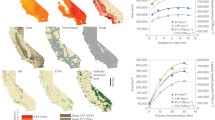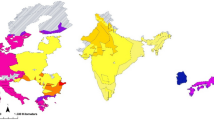Abstract
By 2050, solar energy is expected to provide 45 percent of the electricity consumed in the USA. Most of this solar electricity is expected to come from utility-scale solar projects that each cover anywhere from 10 to thousands of hectares. In all, solar panels could cover as many as four million hectares. Where those panels would be located is uncertain, but predictions are that most of these solar projects would likely occur on agricultural land. Several opportunities and obstacles exist for solar development. The USA has abundant farmland to support solar projects, and the federal government is offering attractive investment tax credits for solar developers over the following 12 years. Yet there is a critical need to expand transmission lines and upgrade the electrical grid to connect new solar projects. Moreover, local governments currently hold the power to decide whether to allow large solar projects, and, if so, where and at what size. Agrivoltaics, which combine in-ground solar panels with the growing of crops, pollinators, and livestock, offer some potential for producing both food and solar electricity. How these many opportunities and obstacles play out will determine the pace and extent of utility-scale solar deployment in the USA.

Photo by Author
Similar content being viewed by others
Notes
A megawatt is a measure of power equal to one million watts, and able to provide electricity to about 190 homes, though the definition of utility-scale solar varies somewhat from state to state (SEIA 2022a).
A gigawatt is a unit of electricity equal to one billion watts, able to power 750,000 homes (Dellinger 2021).
References
Agricultural Marketing Resource Center, Iowa State University (2021) Strawberries. https://www.agmrc.org/commodities-products/fruits/strawberries. Accessed 31 Dec 2022
American Farmland Trust (2022) Smart solar siting on farmland: achieving climate goals while strengthening the future for farming in New York. Washington, D.C.: American Farmland Trust. https://farmlandinfo.org/wp-content/uploads/sites/2/2022/01/NY-Smart-Solar-Siting-on-Farmland_FINAL-REPORT_1.31.22.pdf. Accessed 6 Oct 2022
Angelo H (2023) Boomtown: a solar land rush in the West. Harper’s January, 2023. https://harpers.org/archive/2023/01/boomtown-beatty-nevada-solar-farms-death-valley/. Accessed 29 Dec 2022
Beef2Live (2022) Top 10 States with the most sheep and lambs. https://beef2live.com/story-top-10-states-sheep-lambs-0-117992. Accessed 30 Dec 2022
Biggs N et al (2022) Landowner decisions regarding utility-scale solar energy on working lands: a qualitative case study in California. Environ Res Commun 4:055010
Chan G, Heeter J, Xu K (2022) Sharing the Sun Community solar project data (December 2021). National renewable energy laboratory, Boulder, CO. https://doi.org/10.7799/1845718
Council on Environmental Quality (2021) Federal sustainability plan. https://www.sustainability.gov/federalsustainabilityplan/index.html. Accessed 29 Oct 2022
Crable A, Wheeler T (2022) More than 800 solar projects in Bay states stuck waiting for review. Bay Journal. April 4, 2022 https://www.bayjournal.com/news/climate_change/more-than-800-solar-projects-in-bay-states-stuck-waiting-for-review/article_71a4375a-af6a-11ec-9071-03d4665eb07b.html. Accessed 7 Oct 2022
Daniels T (2022) The potential of nature-based solutions to reduce greenhouse gas emissions from US agriculture. Socio Ecol Pract Res 4(3):251–265. https://doi.org/10.1007/s42532-022-00120-y
Daniels T, Wagner H (2022) Regulating utiity-scale solar projects on agricultural land. Kleinman Center for Energy Policy, University of Pennsylvania, Philadelphia. https://kleinmanenergy.upenn.edu/research/publications/regulating-utility-scale-solar-projects-on-agricultural-land/. Accessed 10 Nov 2022
Dellinger A (2021) Gigawatt: the solar energy term you should know about, November 16, 2021. www.cnet.com. Accessed 29 Sept 2022
Elferink M and Schierhorn F (2016) Global demand for food is rising. Can we meet it? Harvard Bus rev. April 7, 2016.https://hbr.org/2016/04/global-demand-for-food-is-rising-can-we-meet-it#:~:text=Food%20demand%20is%20expected%20to,%25%20to%2098%25%20by%202050. Accessed 28 Dec 2022
Federal Communications Commission (2013) The telecommunications act of 1996. https://www.fcc.gov/general/telecommunications-act-1996. Accessed 13 Nov 2022
Feldman D et al (2022) Spring 2022 solar industry update. Boulder, CO: national renewable energy laboratory. https://www.nrel.gov/docs/fy22osti/82854.pdf. Accessed 8 Oct 2022
Galbraith K (2022) California heat wave: power grid could see near-record demand. San francisco chronicle, September 7, 2022. www.sfchronicle.com. Accessed 22 Sept 2022
Gelles D (2022) The U.S. will need thousands of wind farms. Will small towns go along? New York Times, December 30, 2022 https://www.nytimes.com/2022/12/30/climate/wind-farm-renewable-energy-fight.html?smid=nytcore-ios-share&referringSource=articleShare. Accessed 30 Dec 2022
Griffin S (2021) Electrify: An optimist’s playbook for our clean energy future. MIT Press, Cambridge, MA
https://www.energy.gov/sites/default/files/2021-09/Solar%20Futures%20Study.pdf. Accessed 15 Oct 2022
Gokce C (2022) Lease land for solar farm: 12 Questions to ask (2022), https://gokcecapital.com/lease-land-for-solar-farm/#:~:text=What%20is%20a%20lease%20for,to%20%242%2C000%20per%20acre%20annually). Accessed 29 Dec 2022
Intergovernmental Panel on Climate Change (IPCC) (2022a) Climate change 2022a: Impacts, adaptation and vulnerability, summary for policymakers. https://www.ipcc.ch/report/ar6/wg2/downloads/report/IPCC_AR6_WGII_SummaryForPolicymakers.pdf. Accessed 25 Oct 2022
Intergovernmental Panel on Climate Change (IPCC) (2022b) Climate change 2022b: Mitigation of climate change, summary for policymakers. https://www.ipcc.ch/report/ar6/wg3/downloads/report/IPCC_AR6_WGIII_SPM.pdf. Accessed 25 Oct 2022
International City Management Association and American Planning Association (2021) Solar@Scale: a local government guidebook for improving large-scale solar development outcomes. https://planning-org-uploaded-media.s3.amazonaws.com/publication/download_pdf/Solar-at-Scale-Guidebook.pdf. Accessed 2 Jan 2023
Larsen E. et al (2021) Net zero America, final summary report. Princeton, NJ: princeton university. https://netzeroamerica.princeton.edu/img/Princeton%20NZA%20FINAL%20REPORT%20SUMMARY%20(29Oct2021).pdf. Accessed 6 Oct 2022
Lazard (2021) Levelized cost of energy. https://www.lazard.com/perspective/levelized-cost-of-energy-levelized-cost-of-storage-and-levelized-cost-of-hydrogen/. Accessed 12 Oct 2022
Macknick J. et al (2022) The 5 Cs of agrivoltaic success factors in the United States: lessons from the InSPIRE research study. Golden, CO: national renewable energy laboratory. NREL/TP-6A20–83566. https://www.nrel.gov/docs/fy22osti/83566.pdf. Accessed 18 Oct 2022
Min H (2022) energy post.eu. July 28, 2022. https://energypost.eu/can-chinas-14th-5-year-plan-for-renewable-energy-deliver-an-early-emissions-peak-before-2030/#:~:text=China%27s%20climate%20pledge%20(its%20%E2%80%9Cnationally,non%2Dfossil%20fuels%20by%202030. Accessed 20 Oct 2022
Moore D, Sheehey M (2023) US seeks perfect ‘reese’s cup’ mix of farming and solar panels, Bloomberg Law, January 4, 2023 https://news.bloomberglaw.com/environment-and-energy/us-seeks-perfect-reeses-cup-mix-of-farming-and-solar-panels. Accessed 5 Jan 2023
Morgan K (2021) Market trends for US berry crops: implications for florida blueberry, blackberry, and raspberry producers. gainesville, FL: University of florida extension service. https://edis.ifas.ufl.edu/publication/FE1123. Accessed 30 Dec 2022
National Academy of Sciences (2008) Changes in the sheep industry in the United States. National Academy Press, Washington, D.C. https://nap.nationalacademies.org/resource/12245/SheepFinal.pdf. Accessed 30 Dec 2022
National Renewable Energy Laboratory (2022) Community solar: market status. https://www.nrel.gov/state-local-tribal/community-solar.html. Accessed 29 Dec 2022
NBC News (2008) U.N.: 50 percent more food needed by 2030. https://www.nbcnews.com/id/wbna24942035. Accessed 29 Dec 2022
Pascaris A, Schellya C, Burnham L, Pearce J (2021) Integrating solar energy with agriculture: Industry perspectives on the market, community, and socio-political dimensions of agrivoltaics. Energy Res & Soc Sci 75:102023
Pontecorvo E (2022) Renewables are growing —but a backlog of projects is holding up a greener grid, Grist, April 20, 2022. https://grist.org/energy/renewables-are-growing-but-a-backlog-of-projects-is-holding-up-a-greener-grid/. Accessed 29 Oct 2022
Reiter C (2022) Germany opens farmland to solar power to quadruple capacity. Bloomberg News, February 10, 2022. https://www.bloomberg.com/news/articles/2022-02-10/germany-opens-farmland-to-solar-power-to-quadruple-capacity#:~:text=Germany%20is%20encouraging%20farmers%20to,their%20fields%20for%20solar%20power. Accessed 30 Oct 2022
SolarPower Europe (2021) EU market outlook for solar power 2021–2025. https://api.solarpowereurope.org/uploads/EU_Market_Outlook_for_Solar_Power_2021_2025_Solar_Power_Europe_d485a0bd2c.pdf. Accessed 15 Oct 2022
Solar Energy Industries Association (SEIA) (2022a) What’s in a megawatt? www.seia.org. Accessed 1 Oct 2022a
Solar Energy Industries Association (SEIA) (2022d) US solar market insight. September 8, 2022d. https://www.seia.org/us-solar-market-insight. Accessed 7 Oct 2022d
Solar Energy Industries Association (SEIA) and Wood MacKenzie (2022) US solar market insight executive summary Q3. https://www.seia.org/research-resources/solar-market-insight-report-2022-q3. Accessed 9 Oct 2022
Solar Energy Industries Association (SEIA) (2022b) Solar industry research data. https://www.seia.org/solar-industry-research-data. Accessed 22 Sept 2022a
Solar Energy Industries Association (SEIA) (2022c) Solar by state. https://www.seia.org/states-map. Accessed 10 Oct 2022b
Solar Land Lease (2022) How does a solar farm connect to the grid? https://www.solarlandlease.com/solar-farm-connect-grid. Accessed 6 Oct 2022
United Nations. 2012. Feeding the World Sustainably. UN Chronicle, June 2012. https://www.un.org/en/chronicle/article/feeding-world-sustainably. Accessed 28 Dec 2022
US Department of Agriculture (USDA) (2019) Census of agriculture 2017. USGPO, Washington, DC
US Department of Agriculture, Economic Research Service (2022) Sheep, lamb and mutton https://www.ers.usda.gov/topics/animal-products/sheep-lamb-mutton/. Accessed 29 Dec 2022
US Department of Energy (DOE) (2021) Solar futures study. https://www.energy.gov/sites/default/files/2021-09/Solar%20Futures%20Study.pdf. Accessed 22 Nov 2022
US Department of Energy (DOE) (2022) Inflation reduction act fact sheet. https://www.energy.gov/sites/default/files/2022-08/8.18%20InflationReductionAct_Factsheet_Final.pdf. Accessed 2 Oct 2022
Xiang WN (2019) Ecopracticology: the study of socio-ecological practice. Socio Ecol Pract Res 1(1):7–14. https://doi.org/10.1007/s42532-019-00006-6
Ye Y (2022) China’s solar projects raise land grabbing concerns. Sixth Tone. June 17, 2022. https://www.sixthtone.com/news/1010576/chinas-solar-projects-raise-land-grabbing-concerns. Accessed 22 Oct 2022
Funding
This research was funded in part by a grant from the Kleinman Center for Energy Policy, University of Pennsylvania.
Author information
Authors and Affiliations
Contributions
Professor Daniels was the sole author and sole contributor to the conception and design of this reflective essay. He performed the collection and analysis of the literature cited. He alone wrote the first draft of the manuscript and responded to reviewers’ comments and approved the manuscript.
Corresponding author
Ethics declarations
Conflict of interest
Thomas Daniels is an editorial board member of Socio-Ecological Practice Research. He was not involved in the peer-review or handling of the manuscript, and has no other competing interests to disclose.
Additional information
Publisher's Note
Springer Nature remains neutral with regard to jurisdictional claims in published maps and institutional affiliations.
Rights and permissions
Springer Nature or its licensor (e.g. a society or other partner) holds exclusive rights to this article under a publishing agreement with the author(s) or other rightsholder(s); author self-archiving of the accepted manuscript version of this article is solely governed by the terms of such publishing agreement and applicable law.
About this article
Cite this article
Daniels, T.L. The development of utility-scale solar projects on US agricultural land: opportunities and obstacles. Socio Ecol Pract Res 5, 205–213 (2023). https://doi.org/10.1007/s42532-023-00139-9
Received:
Revised:
Accepted:
Published:
Issue Date:
DOI: https://doi.org/10.1007/s42532-023-00139-9




